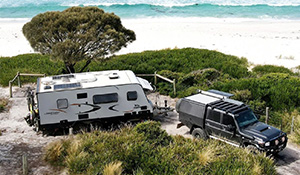Rare Citroen 2CV ‘Sahara’ sells for more than $100,000 at auction.
Double Up Also known as the 2CV 4x4, this Citroen was born out of the need for something light, rugged and reliable to tackle regions where roads were poor or didn’t exist at all. For France, this primarily meant their North African colonies, which they still possessed at the time. In fact, the bulk of 2CV Sahara production appears to have gone to Africa when new. The remainder were scattered through Europe; particularly Spain, whose ‘Guardia Civil’ (Civil Guard) accounted for around 11 per cent went of total production.

The standard 2CV was already adept on rough roads, thanks to its compact size, light weight and four-wheel independent suspension (an unusual arrangement of interlinked leading and trailing arms with horizontal coil springs), but anaemic performance from a 375cc air-cooled flat twin driving the front wheels meant it was anything but rapid. By the way, 2CV stood for ‘Deux Chevaux’ (two horsepower) under France’s engine power rating system.

Of course, this lack of pace was less of a handicap off-road, where mountain goat-like climbing, scrabbling over rocky trails or the ability to push through sand was more important. Engine size increased over the years, but never reached more than 602cc. At the time of the feature car’s creation, 425cc was the norm, although technically, this car is an 850cc as it employs two engines – one in the conventional front position and the other mounted in the rear.

From Quirky to Factory. This unusual means of achieving four-wheel drive had been trialled by a number of individuals and a few enterprising Citroen dealers since the 2CV debuted in 1949. The 2CV’s factory front-wheel drive set-up made it relatively easy to add a second powerplant, as there were no driveshafts and diffs to deal with. Essentially, the rear engine just replicated the front one, but driving the rear axle. In most instances, these experiments and one-offs added a second transmission to the rear, too. By the mid-1950s, there were enough of these home-made ‘4x4’ 2CVs in circulation for Citroen themselves to take notice. Recognising an opportunity to expand sales of their compact commuter, they began their own experiments, developing a prototype in 1957 that was presented to the motoring press a year later. Demand, primarily from the aforementioned North African colonies, saw the 2CV Sahara officially go into production in late 1960.

When new, the Sahara cost more than twice the price of a conventional 2CV, but with two engines and transmissions, you could argue that you were getting twice the car! But, being so expensive and such a specialised vehicle, you had to really ‘need’ a Sahara, rather than ‘want’ one. Of those that served in Africa, most were used by French mining and oil exploration teams who needed its go-anywhere ability, but there is one example of an English anthropologist in Nigeria who needed a vehicle for his work there and chose the 2CV Sahara because it was “friendlier” than the Land Rovers used by unpopular British colonial authorities.

Making it Fit – and Work. The Sahara retained the same basic shape and dimensions as the regular 2CV, but the addition of the second engine presented some unusual packaging challenges. The rear engine took the place of both the spare wheel and fuel tank, so the former was repositioned onto a modified bonnet, while the latter was moved to under the driver’s seat. The fuel tank for the rear engine sat under the front passenger seat. This explains the cut outs in the front doors; to allow refuelling without the occupants getting out of the car - back when service stations still offered “service”.

The rear guards were reshaped and the lower edges raised to reduce the risk or mud and sand fouling the rear wheels. Less obvious changes included air vents cut into the rear of the body to cool the second engine, a modified bootlid, stronger chassis, beefier suspension, reinforced bumper bars and wider wheels and tyres, although the 155-section rubber is still anorexically-thin by modern standards. Inside, there were two keys to start the two engines, while the transmissions were paired through a series of linkages, so the single gear shifter effected change on both gearboxes.

The 2CV Sahara had the ability to run on just the front engine, with a lever alongside the shifter disengaging the rear transmission, but this didn’t work the other way – the engineering did not permit sole rear-engine drive. With both engines running, the 2CV Sahara was capable of around 100km/h top speed, but adding traction to the rear wheels was the real advantage, allowing the car to climb extreme gradients and push its way through sand and heavy ground. Following Algeria’s independence from France in 1962 (when this car was built), the Sahara was renamed the ‘2CV 4x4’ and would remain in production for another four years. When production ended in 1966, less than 700 Sahara/4x4s had been built, making it one of the rarest variants of the 2CV.

European Union. The 2CV Sahara presented here was auctioned by Bonhams at their Monaco sale on 11 May. Like all Saharas, it was built in France, and while its early history is unknown, it spent at least some time in Germany, as a German language service plate is inside. Since the early 1970s, the car has resided in Italy, where it was restored in 2015. With only around 25 examples believed to exist today, the 2CV Sahara is a rare car, so it attracts attention whenever one comes up for auction. This example was no exception, and while it didn’t meet its pre-auction estimate of €80,000 minimum (AU$126,000 approx.), it still sold for an impressive €69,000 (AU$109,026) including buyer’s premium. By comparison, a restored “single engine” 2CV from the same era is worth about a fifth of that.

For more information on this and other lots from Bonhams’ 'Les Grandes Marques À Monaco' sale, go to: bonhams.com. Images: courtesy of Bonhams










